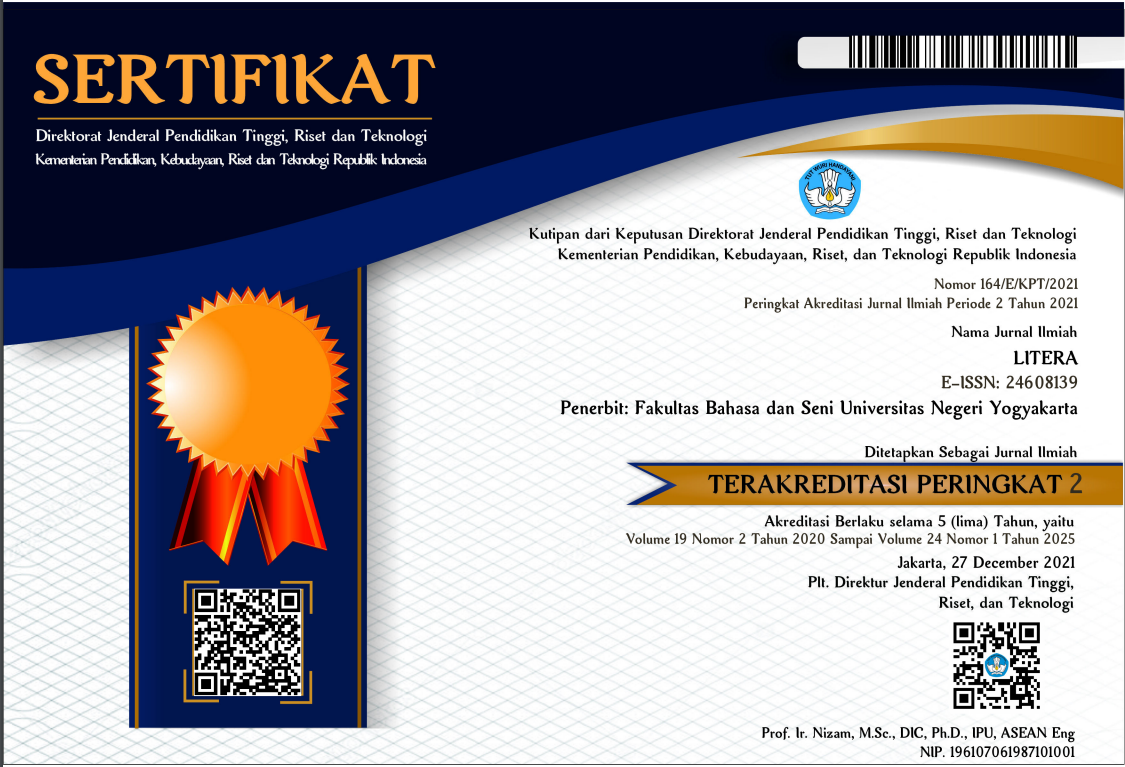The conversion of cognitive interjections in classical English literature into Indonesian
Downloads
Translating interjections is notoriously challenging. Aside from their ambiguous and context-dependent meanings, they also express emotions through broadly suggestive sensations, attitudes, and states of mind. This study attempts to uncover emotional meanings embedded in cognitive interjections, the conversion strategies of cognitive interjections, and how the conversion strategies affect correspondence and equivalence. The data were interjective expressions in the classic English literature entitled "Charlotte's Web" and its Indonesian translation "Laba-Laba and Jaring Kesayangannya", which were scrutinized using content-based mixed methods. The emotional meanings were explored using Jovanović's (2004) theory. The conversion was identified by cultivating Cuenca (2006)'s and Baker (1992)'s proposals. Meanwhile, the implication of the conversions was observed by considering formal correspondence and meaning equivalence. The results suggest that: first, different types of emotional meaning are found in both ST and TT, i.e. anger, disagreement, enquiry, ensurement, hesitation, irritation, pleasure, realization, relief, soothe, and triumph. Second, four conversion strategies are deployed by the translator from English to Indonesian version, i.e. (1) conversion using a similar form and meaning; (2) conversion using a similar form, meaning, and literal translation (triplets) and (3) the conversion through deletion, with the first one as the most often used. Third, while the first two conversions were applicable for producing equivalent expressions, whereas the translator, on the whole, maintains a formal correspondence that equalizes the meaning, the last results in some degree of emotional meaning deviations. This study has demonstrated how inappropriate strategies of rendering interjections may cause distortion of the author's original idea and ruin or reduce the emotional expressiveness in the text.
Keywords: conversion, cognitive interjections, literary translation, translation equivalence
Downloads
Abdullatief, M. (2020). Omission as a Problem and a Solution in Literary Translation: A Study of Hemingway's Hills Like White Elephants and Joyce's The Sisters and Their Arabic Translations. Journal of Languages and Translation, 7(1), 16–42. https://doi.org/10.21608/jltmin.2020.143453
Ameka, F. K. (1992). Interjections: The universal yet neglected part of speech. Journal of Pragmatics, 18(2–3), 101–118. https://doi.org/10.1016/0378-2166(92)90048-G
Ameka, F. K. (2006). Interjections. In Encyclopedia of Language & Linguistics (pp. 743–746). Elsevier. https://doi.org/10.1016/B0-08-044854-2/00396-5
Baker, M. (1992). In Other Words: A coursebook on translation (1st ed.). Routledge.
Bassnett, S. (2005). Translation Studies (3rd ed.). Routledge.
Bí¼hler, K. (2011). Theory of language: The representational function of language. In Theory of Language: The Representational Function of Language. https://doi.org/10.1075/z.164
Burkhardt, A. (1998). Interjektionen: Begriff, Geschichte(n), Paraphrasen. In T. Harden & E. Hentschel (Eds.), articulae particularum: Festschrift zum 60. Geburtstag von Harald Weydt (pp. 43–73). Tubingen.
Catford, J. (1965). A Linguistic Theory of Translation. Oxford University Press.
Cuenca, M. J. (2006). Interjections and Pragmatic Errors in Dubbing. Meta, 51(1), 20–35. https://doi.org/10.7202/012991ar
Dina Begum - - Fiction, novel, human resources, scorecard, management, British Council, fast service, Information and Communication Technology. (n.d.). Retrieved May 1, 2022, from https://www.proz.com/translator/919774
Downe"Wamboldt, B. (1992). Content analysis: Method, applications, and issues. Health Care for Women International, 13(3), 313–321. https://doi.org/10.1080/07399339209516006
Drzazga, A. (2019). Interjections in Shakespeare's Hamlet and their polish translations. Linguistica Silesiana, 40, 83–98. https://doi.org/10.24425/linsi.2019.129403
Drzazga, A. (2021). The English interjection oh in specialist literature and translation. Linguistica Silesiana, 42, 239–259. https://doi.org/10.24425/linsi.2021.137239
Fromkin, V., Rodman, R., & Hyams, N. (2011). An Introduction to Language (9th ed.). Wadsworth Cengage Learning.
Jakobson, R. (1960). Style in Language Closing Statement: Linguistics and Poetics. Style in Language.
Jovanović, V. Ž. (2004). The form, position and meaning of interjections in English (Vol. 3, Issue 1). https://www.researchgate.net/publication/298344430
Kockelman, P. (2003). The Meanings of Interjections in Q'eqchi' Maya. Current Anthropology, 44(4), 467–490. https://doi.org/10.1086/375871
Kridalaksana, H. (2007). Kelas Kata dalam Bahasa Indonesia. PT. Gramedia Pusaka Utama.
Machali, R. (2009). Pedoman Bagi Penerjemah. PT. Mizan Pustaka.
Montes, R. G. (1999). The development of discourse markers in Spanish: Interjections. Journal of Pragmatics, 31(10). https://doi.org/10.1016/s0378-2166(98)00106-4
Munday, Jeremy. (2008). Introducing translation studies : theories and applications. Routledge.
Newmark, P. (1988). A Textbook of Translation. Prentice Hall.
Nida, E., & Taber, C. (1974). The Theory and Practice of Translation. E. J. Brill.
Norrick, N. R. (2009). Interjections as pragmatic markers. Journal of Pragmatics, 41(5), 866–891. https://doi.org/10.1016/j.pragma.2008.08.005
Ní¼bling, D. (2004). Die prototypische interjektion: Ein definitionsvorschlag. Zeitschrift Fur Semiotik, 26(1–2).
O'Connell, D. C., Kowal, S., & King, S. P. (2007). Interjections in literary readings and artistic performance. Pragmatics. Quarterly Publication of the International Pragmatics Association (IPrA), 17(3), 417–438. https://doi.org/10.1075/prag.17.3.04con
Scholes, R. (1974). Structuralism in Literature: An Introduction. Yale University Press Publication.
Thawabteh, M. A. (2010). The translatability of interjections: A case study of Arabic-English subtitling. Meta, 55(3), 499–515. https://doi.org/10.7202/045067ar
Wahid, M. I., & Basari, A. (2020). Techniques of Translating Interjection in the Novel "Looking For Alaska" in Terms of Functions, Meanings, and Categories. E-Structural, 3(01), 31–44. https://doi.org/10.33633/es.v3i01.3854
Wharton, T. (2003). Interjections, language, and the "˜showing/saying' continuum. Pragmatics & Cognition, 11(1), 39–91. https://doi.org/10.1075/pc.11.1.04wha
White, E. B. (1952). Charlotte's Web. Fitzhenry & Whiteside Limited.
White, E. B. (1980). Charlotte's Web. HarperCollins Publishers.
White, E. B. (2020). Laba-Laba dan Jaring Kesayangannya (D. Begum, Ed.). Kakatua.
Wierzbicka, A. (1992). The semantics of interjection. Journal of Pragmatics, 18(2–3), 159–192. https://doi.org/10.1016/0378-2166(92)90050-L
Wills, W. (1982). The Science of Translation. Gunter Narr Verlag Tubingen.
























